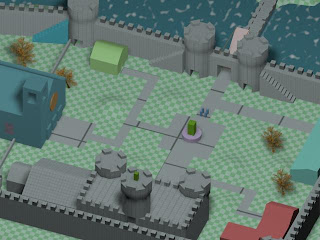Continuing
my series of recent posts analyzing and white-boxing recent D&D
encounters, I give you encounter 4 – The Stables. I switched things up a
bit and did this white-box in the Unreal Engine rather than 3DS Max. I'm a little bit
rusty, but this small encounter was a good way to brush up.
Encounter 4 – The Stables
Encounter 4 – The Stables
So we left off last time with the group entering the castle gates and exploring the main courtyard. You’ll remember from the last entry, that the courtyard is the central hub of my campaign. Most of the main points of interest are accessible from the courtyard, and I give the players free reign as to where they want to explore first. As such, I’ll be tackling blog entries in the order my group tackled the encounters for the sake of story continuity. My group chose to immediately check the stables to the left of the castle gate.
The
stables is a long and simple structure. A large open entrance to the
stables is located on the left end of the building. Inside are a row of
horse stalls along the wall, above is a loft accessible from a ladder
toward the back of the stable. As the players enter, I allow them all
to make a listen check. If any player succeeds, they hear the faint
sound of galloping approaching the castle. Two members of my party
succeeded and turned around to investigate.
The
sound of galloping stops and they see a knight walk through the castle
gate and turn to approach the party. The knight looks normal from a
distance, and the heroes attempt to engage in conversation. The knight
does not answer and continues to approach. Naturally suspicious the
heroes ready their weapons and demand the knight identify himself.
As
the knight gets closer, the party can make out details. What they
thought was a majestic shield with the emblem of a lion has morphed into
a grotesque serpent-like monster. The armor that appeared shiny and
polished from afar now appears charred and black. And finally the
knight’s eyes are empty of life and glowing red.
By the time the players realized the threat, the knight is right next
to them and still approaching the stables. One player stood his ground
blocking the knight’s path. The knight’s body fades and shimmers a bit,
and walks right through the player and into the stables, sapping health
away from the player touched.
The party attacks, but most of their attacks miss as if the the knight is not solid. The knight simply continues walking into the stables and down the aisle of stalls toward the very back. He enters the last stall with the heroes chasing behind, and vanishes. He reappears at the entrance to the stables atop a ghostly horse and a wicked looking spear. The knight charges down the aisle at the party in a ghostly blur!
The party attacks, but most of their attacks miss as if the the knight is not solid. The knight simply continues walking into the stables and down the aisle of stalls toward the very back. He enters the last stall with the heroes chasing behind, and vanishes. He reappears at the entrance to the stables atop a ghostly horse and a wicked looking spear. The knight charges down the aisle at the party in a ghostly blur!
Designer
Note: I designed this encounter to stress to the players the
importance of avoiding the strengths of the opponent, while pouncing on
the weaknesses. The players don’t know quite yet, but soon find out
that the knight is extremely difficult to hit while moving. While
moving the knight is more ghost-like, while standing still the knight is
more corporeal. In addition the heroes need to avoid being charged and
trampled by the horse. Players can strategically position themselves
in the stalls to provide some protection, or an agile character would
race up the ladder to the loft above. The turning point of the battle
is of course when the heroes realize they need to kill the horse first.
Killing the horse means the knight must fight on foot, lowering his
mobility, and thus making him much easier to attack.
The
heroes eat a few nasty attacks before dismounting the knight from his
horse. Once on foot, the party slowly whittles away at his health.
Though still difficult to hit, the fight is much more manageable with
the knight on foot. The ghostly knight is eventually slain, turns to
dust, and leaves behind his armor, shield, and spear. The armor is
again shiny, the shield bright with a lion emblem, and the spear
polished yet still translucent, obviously magical in nature (and an
important quest item). Within the stables the players also find plenty
of torches, lanterns, spears, and helmets should they wish to loot any.
Analysis:
Did the battle work as intended? Only barely. I made the mistake of
giving the horse far too little health. The knight only got off one
charge on horseback before the party ranger buried a quiver full of
arrows into the horse. Most of the players took advantage of the stalls
for cover at first, but only had to do so for a couple rounds before
the ranger had dismounted the knight. Nobody took advantage of the
safety of the loft. The players learned fairly quickly that normal
weapons were less effective than magical forms of damage against this
opponent. Fire arrows and magic from the wizard ended the battle soon
after. If I had to do the encounter again I would give the horse more
health, or give the knight a teleport ability so that he could teleport
away to ready another charge easily. Another option might have been to
give the horse some armor on the front of its body, requiring the
players to flank the horse and attack it from behind.
















